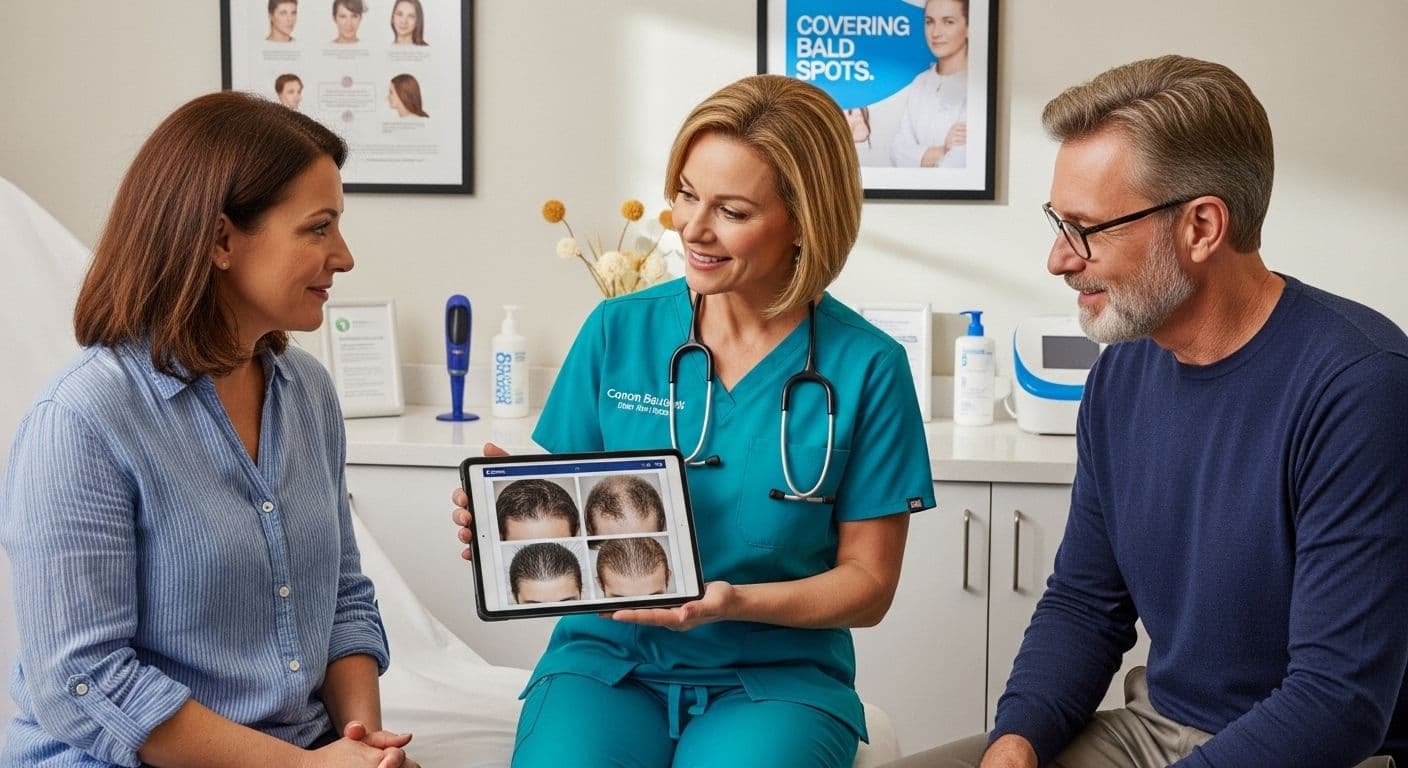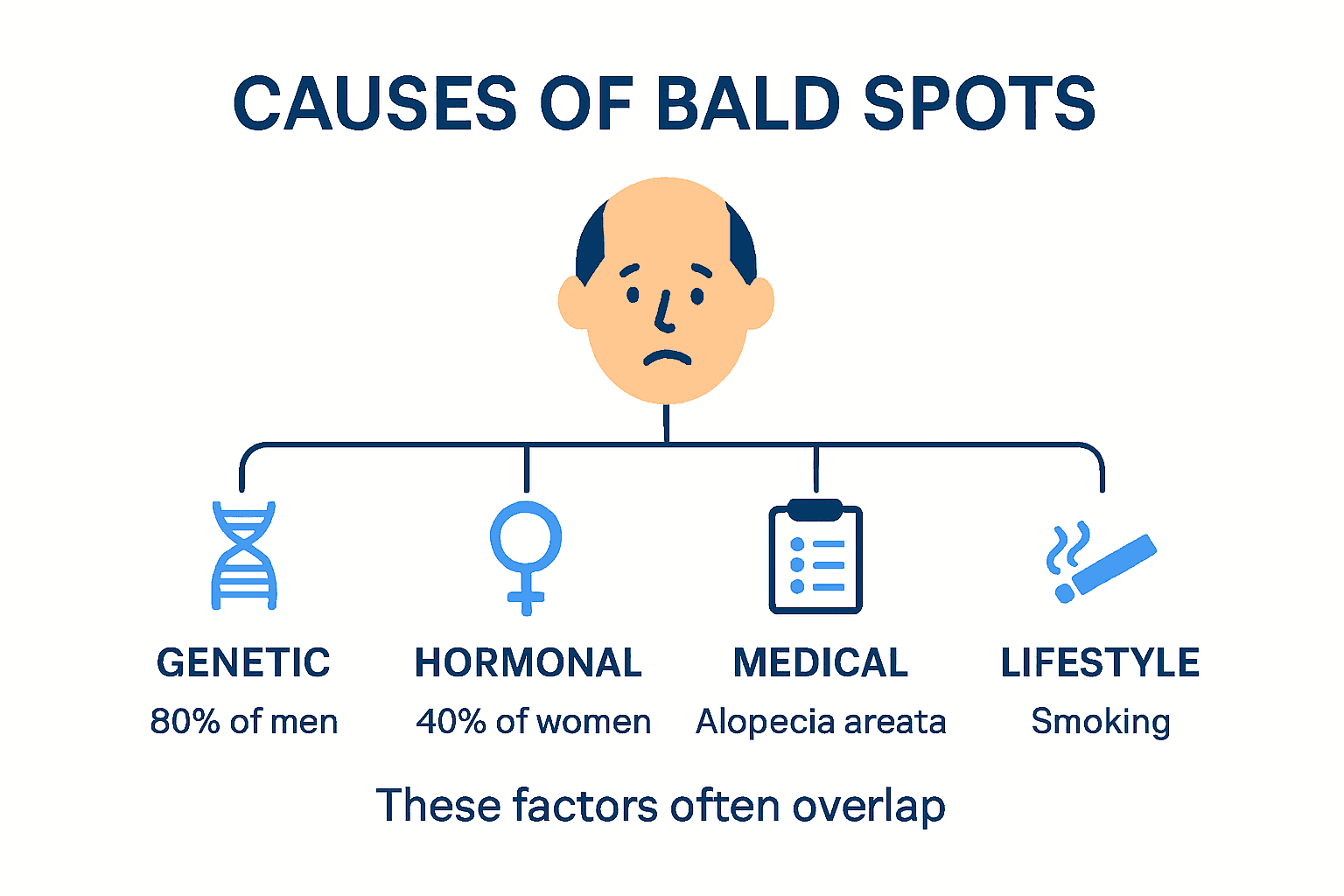Blog
Learning Materials
Covering Bald Spots: Best Tips and Solutions for 2025
Updated: August 6, 2025

Bald spots can sneak up on anyone and by 2025, nearly one in four adults will notice visible thinning or patches. Most people turn to sprays, hats, or bold new haircuts thinking coverage is all about disguising what’s missing. But it turns out quick fixes are only the tip of the iceberg. Modern solutions go deeper with AI-driven treatments, digital scalp analysis, and even natural supplements changing the entire game for getting your hair back.
Table of Contents
- Understanding Causes Of Bald Spots
- Top Techniques For Covering Bald Spots
- Hair Growth Tracking And Personalized Treatments
- Choosing The Right Products And Tools
Quick Summary
| Takeaway | Explanation |
|---|---|
| Identify underlying causes of bald spots. | Understanding genetic, hormonal, and environmental factors is crucial to managing bald spots effectively. |
| Utilize cosmetic solutions for instant coverage. | Products like hair fibers and scalp sprays provide immediate visual improvements for bald spots. |
| Explore advanced hair replacement techniques. | Options such as wigs and hair transplants offer lasting solutions to address severe hair loss. |
| Incorporate technology for personalized treatment. | Digital scalp analysis and AI-driven strategies can tailor interventions to individual hair loss patterns. |
| Select appropriate treatments and products. | Using medically approved treatments and nutritional supplements can significantly enhance hair restoration efforts. |
Understanding Causes of Bald Spots

Bald spots are more than just a cosmetic concern. They represent complex interactions between genetic, medical, and environmental factors that disrupt normal hair growth patterns. Understanding these underlying causes is crucial for developing effective management strategies.
Genetic and Hormonal Influences
Androgenetic alopecia, commonly known as male or female pattern baldness, represents the most prevalent genetic cause of bald spots. According to the Mayo Clinic, this condition is primarily driven by hereditary factors and hormonal changes. Testosterone and dihydrotestosterone (DHT) play significant roles in triggering hair follicle miniaturization, leading to progressive hair thinning and eventual spot formation.
Hormonal shifts during pregnancy, menopause, and thyroid disorders can also contribute to unexpected hair loss. Conditions like polycystic ovary syndrome (PCOS) frequently cause hormonal imbalances that manifest as irregular bald patches.
Medical Conditions and External Triggers
Numerous medical conditions can precipitate bald spot development. Johns Hopkins Medicine highlights several critical factors:
- Autoimmune Disorders: Conditions like alopecia areata cause the immune system to attack hair follicles, resulting in sudden, circular bald spots.
- Nutritional Deficiencies: Insufficient intake of proteins, iron, and essential vitamins can interrupt normal hair growth cycles.
- Chronic Stress: Prolonged psychological stress can trigger telogen effluvium, causing widespread hair shedding and potential bald spot formation.
Additionally, certain medical treatments such as chemotherapy, radiation, and some prescription medications can induce temporary or permanent hair loss. Scalp infections, including ringworm and bacterial conditions, may also cause localized bald spots if left untreated.
Lifestyle and Environmental Factors
Beyond medical causes, lifestyle choices significantly impact hair health. Excessive heat styling, tight hairstyles causing traction alopecia, and harsh chemical treatments can damage hair follicles. Nutritional habits, sleep patterns, and overall physical health directly influence hair growth mechanisms.
For those experiencing persistent bald spots, our comprehensive hair analysis guide offers deeper insights into personalized assessment and potential treatment pathways. Understanding your specific hair loss pattern is the first step toward effective management and potential restoration.
Top Techniques for Covering Bald Spots
Managing bald spots requires a multifaceted approach that combines aesthetic solutions, technological innovations, and strategic styling techniques. Understanding the range of available options empowers individuals to confidently address hair loss and enhance their appearance.
Cosmetic Camouflage Solutions
Cosmetic technologies have revolutionized bald spot coverage. According to the Memorial Sloan Kettering Cancer Center, several advanced products can effectively conceal hair loss:
- Hair Fibers: Keratin-based microfibers that attach to existing hair, creating instant volume and coverage
- Scalp Sprays: Colored sprays that match your natural hair tone and minimize visible bald areas
- Concealer Powders: Pigmented powders that blend seamlessly with existing hair
These products offer immediate visual improvement and can be used individually or in combination for enhanced results. Users appreciate their ease of application and natural-looking finish.
Advanced Hair Replacement Techniques
For more comprehensive solutions, several professional techniques provide substantial coverage. The National Alopecia Areata Foundation highlights multiple approaches:
- Hairpieces and Wigs: Custom-fitted options designed to match natural hair texture and color
- Scalp Micropigmentation: A semi-permanent tattoo technique that creates the illusion of hair follicles
- Hair Transplant Procedures: Surgical methods that redistribute existing hair to cover bald spots
Each technique offers unique advantages depending on individual hair loss patterns, budget, and personal preferences. Consulting with a hair restoration specialist can help determine the most suitable approach.
Strategic Styling and Accessories
Beyond medical interventions, strategic styling can effectively minimize the appearance of bald spots. Techniques include:
- Careful haircut designs that redistribute hair volume
- Using specialized styling products with volumizing properties
- Incorporating accessories like hats, scarves, and headbands
Our comprehensive hair restoration guide provides personalized insights into managing bald spots with confidence. Professional stylists and trichologists can offer tailored advice for individual hair loss scenarios, ensuring a comprehensive and compassionate approach to hair restoration.
Below is a table comparing the main options for covering bald spots, summarizing their key uses, duration, and considerations:
| Solution Type | Example Methods | Typical Duration | Key Considerations |
|---|---|---|---|
| Cosmetic Camouflage | Hair fibers, scalp sprays, powders | Temporary (hours) | Quick, easy, non-invasive |
| Hair Replacement Techniques | Wigs, micropigmentation, transplant | Semi-permanent to permanent | Professional, higher cost |
| Strategic Styling/Accessories | Haircuts, headbands, hats | Varies with style | Conceals but doesn't regrow |
Hair Growth Tracking and Personalized Treatments
The landscape of hair loss management has transformed dramatically with technological advancements that enable precise, individualized approaches to tracking and treating bald spots. Modern solutions leverage data-driven methodologies to provide unprecedented insights into hair health and growth potential.
Digital Scalp Analysis Technologies
Cutting-edge digital imaging technologies have revolutionized hair loss assessment. Trichoscopy, a sophisticated digital scalp imaging technique, allows dermatologists and hair specialists to capture high-resolution images that reveal intricate details about hair follicle health, density, and potential growth patterns.
These advanced diagnostic tools offer multiple benefits:
- Precise measurement of hair follicle diameter
- Detailed tracking of hair growth cycles
- Early detection of potential hair loss progression
- Quantitative analysis of scalp health
By generating comprehensive digital maps of an individual's scalp, these technologies enable healthcare professionals to develop targeted, personalized treatment strategies.
AI-Powered Personalized Treatment Strategies
According to recent research published in the National Institutes of Health, machine learning algorithms are increasingly being integrated into hair loss management. These intelligent systems analyze multiple data points, including genetic predisposition, hormonal profiles, lifestyle factors, and historical hair growth patterns to recommend customized interventions.
Personalized treatment approaches may include:
- Targeted nutritional supplements
- Precision medication dosages
- Customized topical treatments
- Tailored lifestyle recommendations
Continuous Monitoring and Progress Tracking
Modern hair restoration strategies emphasize ongoing assessment and adaptation. Our comprehensive hair tracking guide demonstrates how continuous monitoring allows individuals to understand their unique hair growth journey.
Key components of effective tracking include:
- Regular digital scalp photography
- Quantitative hair density measurements
- Comprehensive symptom and treatment response logging
- Periodic consultations with hair restoration specialists
By embracing these data-driven approaches, individuals can move beyond generic solutions and develop highly personalized strategies for addressing bald spots and promoting optimal hair health. The future of hair restoration lies in understanding each person's unique biological landscape and crafting interventions that respond precisely to individual needs.
Choosing the Right Products and Tools
Selecting appropriate products and tools for managing bald spots requires careful consideration of individual hair loss characteristics, underlying causes, and personal treatment goals. A strategic approach can significantly improve hair restoration outcomes and overall scalp health.
Topical Treatments and Pharmaceutical Options
The American Academy of Family Physicians highlights several critical pharmaceutical interventions for hair loss management. Topical treatments like minoxidil (Rogaine) represent a primary line of defense for many individuals experiencing bald spots.
Key pharmaceutical considerations include:
- Minoxidil: A widely used topical solution promoting hair regrowth
- Finasteride: An oral medication that addresses hormonal causes of hair loss
- Corticosteroid Treatments: Effective for managing certain types of alopecia
Professional medical consultation remains crucial in determining the most appropriate pharmaceutical approach, as individual responses can vary significantly.
Nutritional Supplements and Natural Solutions
A comprehensive systematic review in JAMA Dermatology examined the potential of nutritional supplements in hair restoration. Several supplements have demonstrated promising results in supporting hair health:
- Viviscal: A marine protein-based supplement
- Nutrafol: A holistic approach targeting multiple hair growth factors
- Biotin Complexes: Supporting keratin production and hair strength
It is essential to approach nutritional interventions with realistic expectations and under professional guidance. Supplements can complement other treatment strategies but are not standalone solutions.
Advanced Hair Restoration Tools
Technological advancements have introduced sophisticated tools for managing bald spots. Our comprehensive hair restoration guide explores cutting-edge solutions that go beyond traditional treatments.

Innovative tools and technologies include:
- High-frequency scalp stimulation devices
- LED light therapy systems
- Advanced scalp massage tools designed to enhance circulation
- Digital tracking applications for monitoring hair growth progress
The following table provides a summary of types of hair loss solutions, their main examples, and their core benefit:
| Category | Main Examples | Core Benefit |
|---|---|---|
| Topical & Pharmaceutical | Minoxidil, finasteride, corticosteroids | Promote/regrow hair, manage causes |
| Nutritional Supplements | Viviscal, Nutrafol, biotin complexes | Support hair strength/growth |
| Device/Technology Tools | Scalp massage, LED therapy, digital tracking apps | Stimulate growth, monitor progress |
| Cosmetic Camouflage | Hair fibers, sprays, powders | Immediate coverage |
| Replacement Techniques | Wigs, micropigmentation, transplants | Long-lasting/full coverage |
| Styling & Accessories | Volumizing products, hats, headbands | Concealment, confidence |
Effective product selection requires a holistic understanding of individual hair loss patterns. Consulting with trichology specialists can provide personalized recommendations tailored to specific scalp conditions and hair restoration objectives. The future of hair loss management lies in integrated, data-driven approaches that combine medical expertise, technological innovation, and personalized treatment strategies.
Frequently Asked Questions
What are the common causes of bald spots?
Bald spots can arise from genetic factors like androgenetic alopecia, hormonal changes, autoimmune disorders, nutritional deficiencies, chronic stress, and lifestyle choices such as heat styling or tight hairstyles.
What cosmetic solutions can effectively cover bald spots?
Cosmetic options include hair fibers, scalp sprays, and concealer powders, which provide instant visual coverage and can be used together for enhanced results.
How do advanced hair replacement techniques work?
Advanced hair replacement techniques include custom wigs, scalp micropigmentation, and hair transplant procedures, which provide lasting solutions by either redistributing existing hair or creating the illusion of hair on the scalp.
What are the benefits of digital scalp analysis and AI-driven treatments?
Digital scalp analysis allows for precise assessment of hair health and growth patterns, while AI-driven treatments can personalize interventions based on individual data, optimizing the effectiveness of hair restoration strategies.
Ready for Real Answers About Your Bald Spots?
You have just learned how bald spots in 2025 are shaped by genetics, stress, hormones, and harsh styling. Applying quick camouflage can help, but trying to guess the cause or track progress alone can feel overwhelming. If you want to finally break free from the frustration of guesswork and uncertainty, let technology work for you instead.

Experience the confidence of pinpoint answers. With MyHair.ai, upload a simple scan, get a digital scalp analysis, and receive personalized product recommendations built for your unique needs. Track your results over time with AI insights. Take action today because every day delayed is another day missed for effective regrowth. Discover your personalized path at MyHair.ai or find more practical solutions in our bald spot treatment guide.